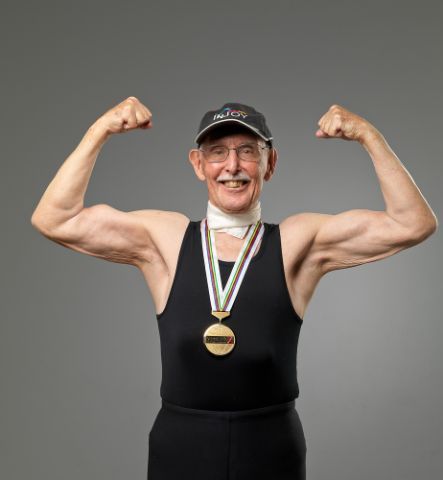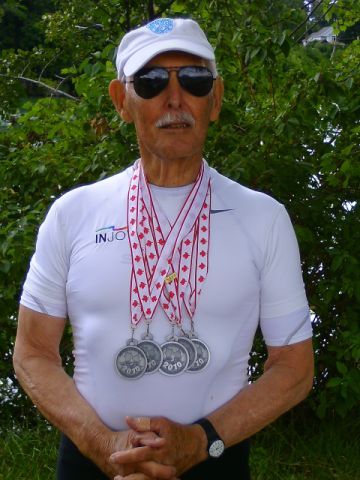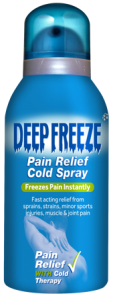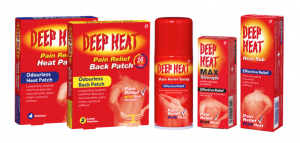London: When we meet Dr Charles Eugster, a former dentist, is wearing a stylish grey cashmere suit, with a white cotton shirt, complimented by a pink silk tie and matching pocket handkerchief. The suit doesn’t hang as it would on most men his age but fits perfectly on his trim and moderately defined muscular physique. He may be 91-years-old but unlike the majority of his contemporaries he has no superflous hair peeking from his nostrils or ears and has a decent haircut.
When I compliment him by telling him he looks 30 years younger than his real age – which he does. He responds by saying that he doesn’t need Viagra nowadays (not that he took it before). And as a once-divorced widower he is looking forward to his next internet date. His last relationship was with a 72-year-old synchronised swimmer.
The secret to his youthfulness is not down to any cosmetic surgery. His “elixir of life” is exercise. And not a punishing regime either – just 45 minutes, three times a week.
 Charles in competition – October 2010
Charles in competition – October 2010
His workout, is based on building and retaining muscle mass. The dramatic fall in muscle mass in older people, known as sacrophenia, is a major contributor to frailty among the elderly. He lifts weights and combines this with resistance training and cardio workout through rowing. His regime has not only changed his body shape – his weight has decreased from 85 to 65 kilos, but has also boosted levels of his youth hormones. It is scientifically proven, that levels of Human Growth Hormone – the main youth hormone – are boosted through exercise.
A blood analysis has also revealed he has the profile of an athlete and an absence of the nasty substances that usually accompany ageing such as high levels of bad LDL cholesterol. His resting heart rate is also in the 50s which is near athletic.
He also claims that exercise has also had an interesting affect on the colour of his body hair. He tells me that his once grey pubic hairs have returned to their original colour – although Elixir clearly cannot testify to this!
He claims to be the fittest nonogenerian on the planet. And looking around on the streets of the UK where woman are now the most obese in Europe – he may well be right.
 Charles Eugster brims over with enthusiasm for life and is now on a one-man mission to not only get older folks off their feet to take more exercise but also to reinvent themselves in new careers.
Charles Eugster brims over with enthusiasm for life and is now on a one-man mission to not only get older folks off their feet to take more exercise but also to reinvent themselves in new careers.
“After all”, he says, “they have another thirty years to live.” And he believes this is where “vanity” has a positive role. “I am vain and it has its place as a motivator. If you want to stay young then act young – join a gym, be competitive and find a new job.”
Charles doesn’t take hormone replacement, or expensive supplements, or even count calories. He does have a personal trainer who advices on changes to his exercise regime so that his body is constantly challenged. He recently decided to target his derierre which his personal trainer says is now “firming up nicely”.
As far as diet goes, he eats lots of fruits, vegetables and porridge. He also he takes whey protein which helps build lean muscle, confesses to the odd glass of wine and drinks green tea.
There is no question that Charles is a role model for older people. He “retired” as a dentist and publisher of a newsletter for dentists well past the usual retirement age at the age of 75. And has now embarked on a career to promote positive ageing. He has his own website www.charleseugster.net , is a prolific Tweeter and is also in the process of writing an “inspirational book” about ageing. He is also a “Fitness Ambassador” for INJOY, a gym chain in Continental Europe aimed at babyboomers.
Born in England but now living in Zurich, Switzerland, Charles has an accent that is “cut glass” British. His wealthy parents sent him to St Pauls, the London public school which is where he learned to row.
The turning point for his health came in his 50s when he discovered varicose veins on his legs and was diagnosed with low blood. His doctor said he needed to take more exercise so he took up walking and then jogging
“To my surprise my first wife was not interested in sport at all so I tried to adapt to her lifestyle which was not good for me at all.” They later divorced and his second wife died tragically in a car crash in France.
At the age of 87, he decided to take up body building to counter muscle loss. Last year (2010) he won the Strenflex World Championship (an international fitness competition) in the over 80-age group with the highest number of points ever scored. His winning performance featured 57 dips, 61 chin-ups, 50 push-ups and 48 abdominal crunches, each in 45 seconds!
Dr Eugster has won 31 International rowing Gold medals and added 5 more Gold’s at the recent World Masters Regatta in Canada.
He is a vehement supporter of the UK’s Government’s decision to phase out the Default Retirement Age (DRA). As a passionate evangelist for being fit in old age, he has clear views about making sure one has correctly provided for one’s later years and he points out that a healthier ‘old old’ population will make fewer demands on an exceptionally stretched health service.
Dr Eugster says: “The aged are considered not only to be unproductive but to put an enormous strain on the health service. It is claimed that in the UK, services for the aged already cost £126 Billion or 60% of all social services.” He continues, “The blessings of work have been underestimated – those that work are statistically healthier and recover faster from illness. There is satisfaction in earning one’s keep. The horror of retirement has also been underestimated – the prospect of no longer making a contribution to society, of loss of status, of loss of satisfaction of earning money and of slow mental and physical decline.
“The retirement age of 65 was first introduced at the turn of the century when life expectancy was 46. In the meantime life expectancy has increased by about 74%, but retirement age has remained the same. The enormous growth of the aged population has made the present pension system unaffordable. An increase in retirement age and a reduced pension is politically difficult but would be made easier by encouraging work after retirement with training facilities with the object of learning a new profession or starting a new career- which could be full-time, part-time or temporary.”
Dr Eugster surmises:”It is absurd that we should spend about a third of our lives being unproductive and supported by other people’s children. The discovery of the enormous plasticity of the human body means that it is possible to rebuild one’s body and mental ability in old age through specific exercises and changes in diet. This in turn cannot only prevent decline but can increase physical and mental powers. Thus the possibility of work in old age together with fewer demands on the health services is feasible.”
And you only have to look at Charles to know that he is right.
To find out more about Dr Eugster www.charleseugster.net/
Interview by Avril O’Connor





 Charles Eugster brims over with enthusiasm for life and is now on a one-man mission to not only get older folks off their feet to take more exercise but also to reinvent themselves in new careers.
Charles Eugster brims over with enthusiasm for life and is now on a one-man mission to not only get older folks off their feet to take more exercise but also to reinvent themselves in new careers.